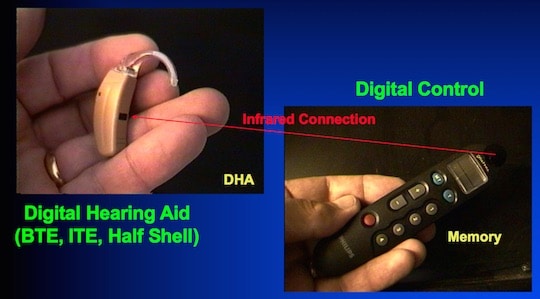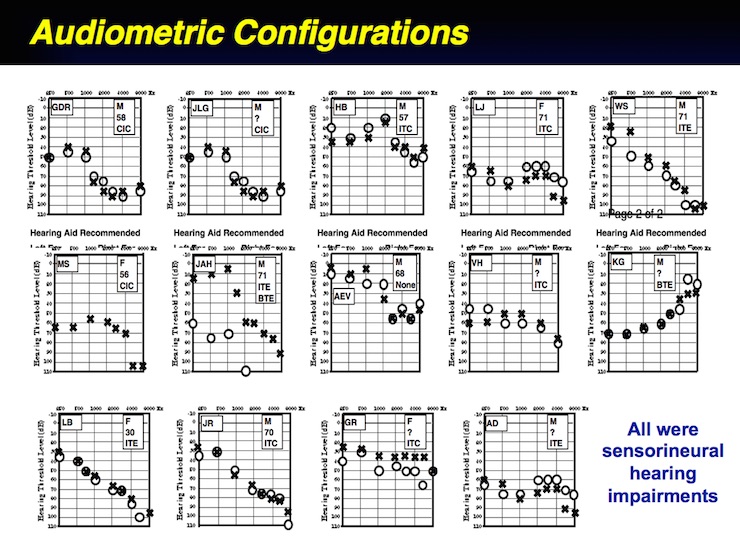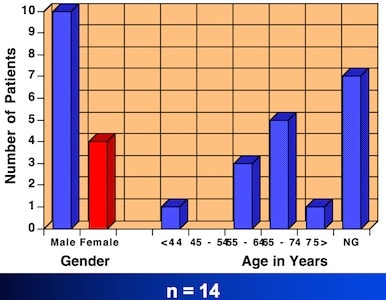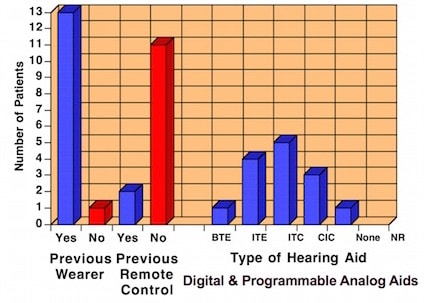Or, Would You Select a Different Hearing Aid Setting if the Choice Was Yours?
How satisfactory is the hearing aid setting for consumers when they leave the dispenser’s office? Is it the optimum fitting, or would some other setting have been more acceptable? Would there be any differences in the final selection if the consumer were allowed to select the hearing aid basic operational system as opposed to that selected by the dispenser?
Hearing aids have improved dramatically in the past decades, providing outstanding results for the hearing impaired. The fact remains, however, that no hearing aid electroacoustics provides a complete substitute for one’s original hearing. Complicating the situation is that consumers have non-specific subjective requirements that may ultimately determine the successful use of the hearing aid. Knowing this, what hearing aid characteristics might a consumer select if multiple signal processing schemes (essentially different hearing aids, not just different environmental, gain, or response) were available for evaluation during the fitting process?
Note: As one scans through computer files, it is not uncommon to uncover results of unpublished studies that contain informative data. Such was the case with the study results reported in this post and related data, to be published in following weeks.
The data that follows is the result of a comparison of consumer subjectively preferred signal processing schemes against recommendations made by audiologists.
Study Method
The purpose of the study was to compare patient preferences for a given signal processing approach against an audiologist’s recommendation. Fourteen hearing-impaired adult subjects were provided with four different signal processing schemes to allow for paired-comparisons between the schemes. Thirteen of the subjects were wearers of hearing aids and one had never worn a hearing aid. All subjects used the same hardware (software controlled open platform), and each subject was fitted according to an appropriate hearing aid fitting formula for the signal processing scheme recommended by the audiologist. The evaluated system was a Philips Open Platform hearing aid, remote, and software (no longer manufactured).
Difference between an open platform and closed/fixed platform hearing aid
To follow this discussion, it is important to have a basic understanding of the underlying signal processing schemes behind this research.
A fixed (closed) algorithm platform hearing aid has an inherent processing scheme or rule set governing performance that cannot be changed by either the dispenser or the hearing aid wearer. The performance parameters (gain, response, compression ratio, knee point, output, threshold, noise reduction, etc.) can be modified somewhat, but are limited to the engineered performance of the digital chip. Current hearing aids are primarily fixed platform hearing aids.
An open platform system allows a variety of algorithms (essentially different hearing aids) to be loaded into a single instrument. The sound processing algorithms can be chosen from an existing library of software and from a potentially large library of software signal processors yet to be developed. To the best of the writer’s knowledge, there are no truly open platform hearing aids in the market currently.
A full explanation of the difference between the two platforms is contained in an article by Staab, Preves, Yanz, and Edmonds{{1}}[[1]]Staab, W., Preves, D., Yanz, J., and Edmonds, J. Open platform DSP hearing instruments: a move toward software-controlled devices. The Hearing Review, Dec. 1997, pp. 22-24, 27[[1]].
In this study, each subject was given four (4) different signal processors (hearing aids) in one, with one of the four being the recommendation of the audiologist. Subjects were given a remote control that allowed them to select between the four signal processing schemes (wearing the same hearing aid), and then completed a self-questionnaire to describe their use with the four different hearing aids. The two questions to be answered were:
- What signal processing in the hearing aids was preferred, and
- What was the subject’s reaction to the use of a remote control to allow signal processing selection under different listening conditions?
For this post, number 1 is the area of interest.
Algorithms and Selection Process
Four (4) different hearing aids (in a single BTE case, but with the processing scheme selectable using a remote control) were provided to each subject, with the audiologist determining which of the signal processing schemes was preferred (based on the audiogram and counseling with the subject). The signal processing scheme was selected by the audiologist to provide one of the following subjective features:
- FIDELITY: Single-channel broadband input and output AGC (automatic gain control), using the NAL-R fitting formula.

- COMFORT: Two-channel TILL{{2}}[[2]]Killian, M., Staab, W., and Preves, D. Classifying automatic signal processors, Hearing Instruments, Vol. 41, No. 8., 1990[[2]] input and output ACC, based on the Fig6 fitting formula.

- CLARITY: Two-channel BILL input and output AGC, using the NAL-R fitting formula.

- EQUALIZER: Four-channel input and output AGC having independent control of performance in each channel, using the DSL I/O fitting formula.

The system used for the study is shown in Figure 1. The hearing aid was a digital behind-the-ear (BTE) instrument. It contained an open platform chip that could be directed by the hand-held remote. In a sense, the hearing aid was like the operating system of a computer, and the hand-held remote served as the memory, accessible to different applications that could be ‘run’ on the hearing aid. The remote could be programmed to any of the algorithms (Fidelity, Comfort, Clarity, or Equalizer for this study, but could have numerous others as well), with each of these corresponding to buttons 1, 2, 3, or 4 on the Remote. To change from one hearing aid to a completely different hearing aid (these are NOT environmental settings but completely different hearing aid algorithms) required a simple push of one of the four buttons. Current hearing aids provide primarily a single algorithm, but within that algorithm, the hearing aid parameters (gain, response, AGC knee, limiting, directionality, CR, etc.) can be changed by the computer programming software. That is NOT the same as having different hearing aid basic characteristics. Think of this difference as follows: In Figure 1, the hearing aid contains a chip that can be modified or updated to accommodate a wide range of signal processing possibilities, selectable with the remote (in this case, up to four different schemes – buttons 1, 2, 3, and 4). If a contemporary product, the hearing aid most likely has a signal processing scheme hardwired or hardcoded into the chip, allowing for some parameters to be adjusted (including access to be adjusted via a remote control), but the function of the chip cannot be changed without a costly and time-consuming redesign.

Figure 1. The system used in this study. The hearing aid worn is shown on the left. In this study, it consisted of a BTE (behind-the-ear) hearing aid only. The multi-programmer remote control on the right was loaded with four different digital hearing aid signal processing schemes intending to provide fidelity, comfort, clarity, and equalization. To add new algorithms, new software is loaded into the Remote, but no change is made to the hearing aid itself. Software in an office or laptop computer is communicated to the Remote directly via a RS232 connector, the cable system of the Hi-Pro box, by Smart Card connection, or acoustically by teleprogramming. Each of the Remote signal processing schemes could have the electroacoustic characteristics modified by altering up to 34 different parameter sittings. This was accomplished through the software fitting program.
Hearing Levels
Audiograms of the subjects are shown in Figure 2, with all subjects having been diagnosed as having sensorineural hearing loss. It was believed helpful to view the actual audiograms rather than mean and standard deviations so that later, subjective results could be directed to a specific audiogram.

Figure 2. Audiometric configurations of the fourteen (14) subjects used in this study.
Gender and Age
The gender and age of the subjects is shown in Figure 3.

Figure 3. Gender and age distribution of the subjects used in the study.
Hearing Aids Worn by Subjects at the Time of Study
The number of subjects that were already wearing hearing aids, and considered experienced users, along with the types of hearing aids worn at the time of the study is shown in Figure 4.

Figure 4. Previous hearing aid use of the subjects used in the study, along with the type of hearing aid they were wearing at the time of the study.
Question
Will consumers, when given the opportunity to chose, use the same signal processing strategy (Fidelity, Comfort, Clarifier, Equalizer) as selected by the audiologist to be most appropriate for them, after they have used the instruments for a certain period of time? Will their preferences change after two weeks to two months?
Next week’s post will report on the results of subject preferences for the different signal processing strategies during their first week of use and then subject preferences from the second week to two months. The current post is intended to provide background for the results to be published next week.






Excellent sense of humour.
Thanks for explaining the best settings for your hearing aids. I agree that you want to find something that is going to be the right size for your ear as well. My husband and I are looking for hearing aids for our son, so we’ll have to consider the size first.